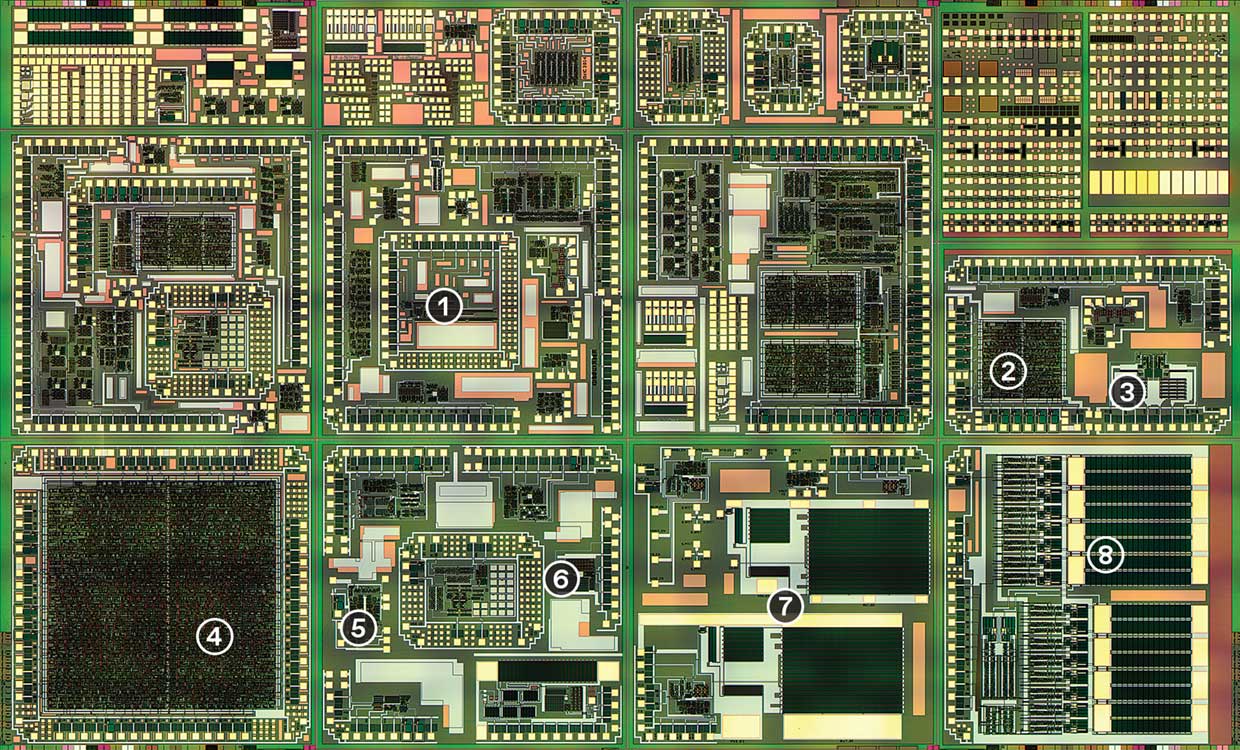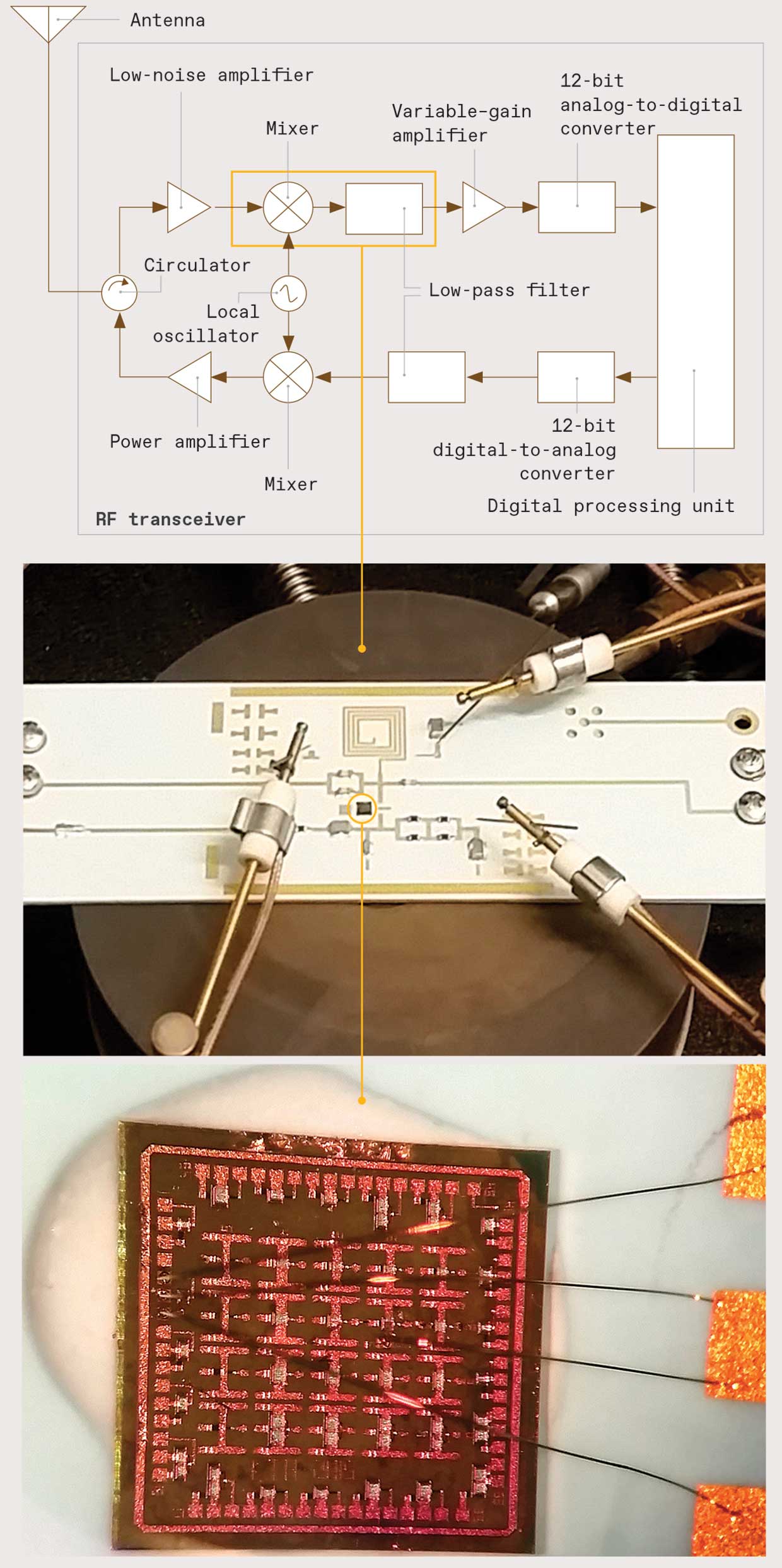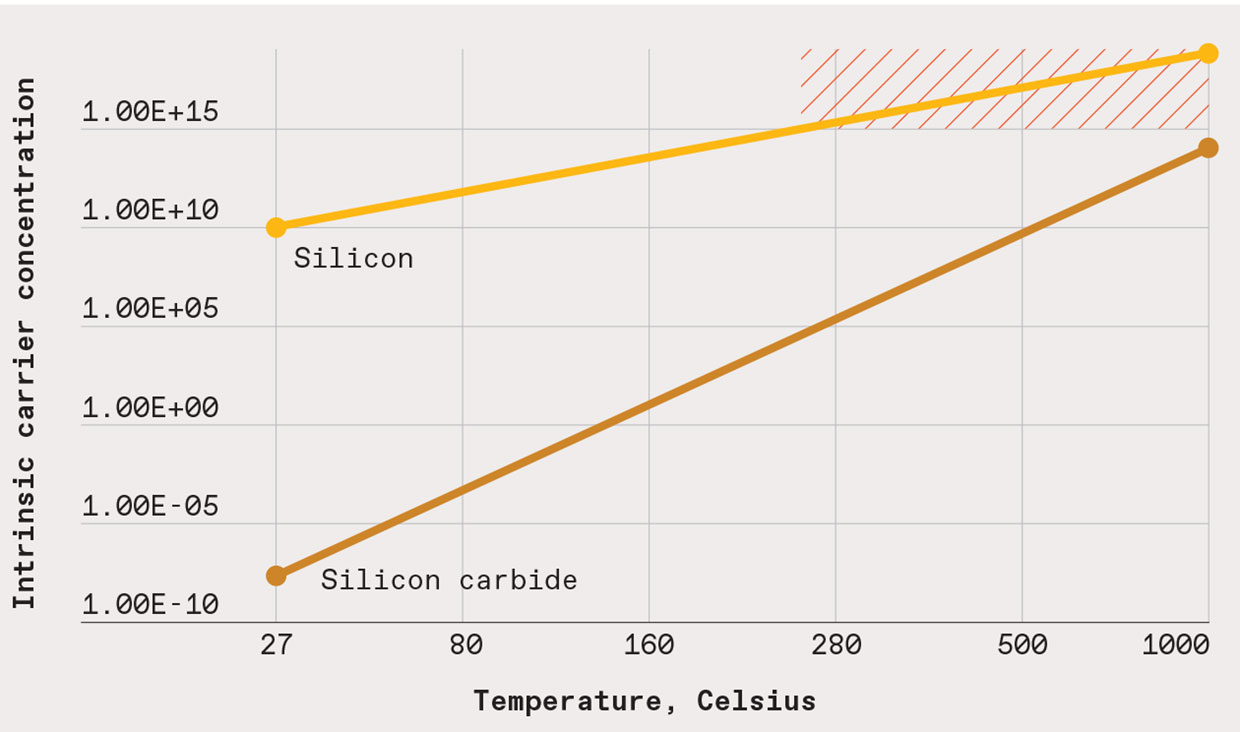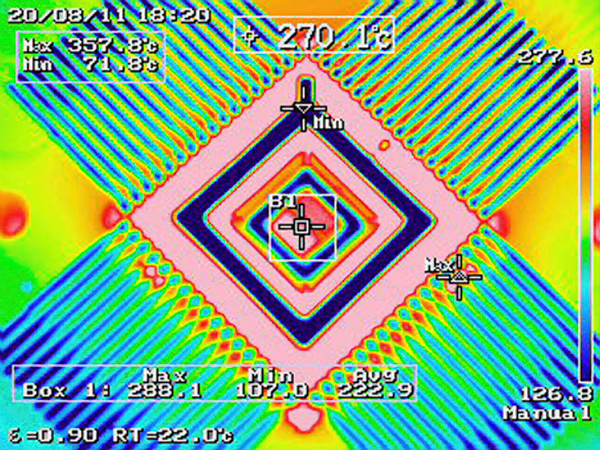Silicon carbide radio circuits can withstand the volcanic heat of Venus

As an artist, he imagines a future Venus rover, which receives energy from the wind blowing in the dense atmosphere of Venus.
In the summer of 2020, at the height of the pandemic, there were some advantages. One of them was the flight of American astronauts to the ISS and their successful return on a commercial rocket from SpaceX. This event was important for many reasons, one of which is as follows: when NASA is relieved of the need to deliver people to low Earth orbit, the agency will be able to target more distant targets. Maybe even to Venus.
Excitement about a possible mission to Venus spurred the discovery of phosphine in its atmosphere - a possible sign of microbial life (although this discovery is now disputed). However, the conditions on the second planet from the Sun are so harsh that the lander that lasted the longest there, Venera-13 (USSR), was able to transmit data for only 2 hours 7 minutes. The average temperature on the surface of Venus is 464 ° C, the atmosphere is full of droplets of sulfuric acid, easily corroding metals, and the atmospheric pressure on the surface is 90 times higher than that of the Earth. And yet, scientists consider Venus to be the twin of our planet.
The sizes and masses of the two planets are almost the same. Based on some evidence, huge oceans may have existed on Venus for 3 billion years - and, therefore, there could have been life. What cataclysms led to the loss of water by Venus? Planetary scientists would love to know this - perhaps it will tell us about our own fate in connection with climate change.
To solve this and other mysteries of Venus, we need to build some clever robotic descent vehicles. But will we be able to make machines with tools, means of communication, controlled and mobile, capable of surviving in such a hostile environment not for hours, but for months and years?
We can. Materials production technology has made great strides since the 1960s, when the USSR launched a series of lander to Venus. Now we will be able to make sure that the hull and mechanics of the future descent vehicle will be able to withstand there for several months. What about delicate electronics? In the Venusian environment, today's silicon systems won't last a day. An Earth day, of course - a day on Venus lasts 243 Earth days. And even active cooling systems will not extend their life by 24 hours.
The answer was a semiconductor, combining two common elements, carbon and silicon, in a 1 to 1 ratio: silicon carbide, SiC. It is able to withstand extremely high temperatures while functioning perfectly. At Glenn Research Centerat NASA, silicon carbide circuits have been operating for over a year at a temperature of 500 ° C. This demonstrates the fact that they are able to withstand such temperatures, and at the time intervals that the Venusian lander would require.
Silicon carbide is already being used in power supply circuits for solar inverters, electric motor electronics, and advanced smart grid switches. However, creating silicon carbide circuits capable of driving an all-terrain vehicle in the hellish conditions of Venus, and sending data from there to Earth, will test the material to the limit of its capabilities. If successful, we will get more than just a mobile outpost in one of the least friendly points in the solar system. We will understand how to send wireless sensors to places on Earth that we have never sent before - to the turbine blades of jet aircraft and gas turbines, to the heads of oil drills, to the center of various high-temperature and high-pressure manufacturing processes. The ability to place electronics in such locations may well reduce the cost of both operating and maintaining equipment.and also to increase its effectiveness and safety.
Our team of scientists from the Royal Institute of Technology (KTI) in Stockholm and from the University of Arkansas in Fateville believe that silicon carbide circuits can do all this and more - they are capable of things that we cannot even imagine.

The Vulcan II is a silicon carbide analog and digital chip designed for performance testing at 500 ° C. So far we have made 40 circuits using the Vulcan II chip and its predecessor.
1. Ring generator
2. 8-bit SAR analog-to-digital converters and 4-bit ramp analog-to-digital converters
3. RS 485 receiver
4. 8-bit adders and 4-bit multipliers
5. 555 timer
6. Three-stage operational amplifier
7. DC-DC current converter
8. Integrated gate drivers
Silicon carbide is not a new material. The beginning of its large-scale production is associated with the name of Edward Goodrich Acheson , who in 1895 invented the process of synthesizing silicon carbide (carborundum), which is still used for production today. He tried to get artificial diamonds, but as a result of the experiment, SiC crystals appeared. For the first time, the material was successfully used to work with electricity in 1906 - then Henry Harrison Chase Dunwoody invented a radio detector. To this day, it is considered the first commercial semiconductor device.
However, it is extremely difficult to establish reliable production of large crystals of carborundum. It wasn't until the 1990s that engineers invented equipment that could grow crystals good enough to be used to make power transistors. The first silicon carbide plates were only 30 mm in size, but gradually the industry moved to plates of 50, 75, 100, 150 and even 200 mm. Increasing the size of the plate increases the efficiency of the device. Over the past 20 years, research and production has advanced so much that silicon carbide power semiconductors can already be purchased.
A silicon carbide semiconductor has several very attractive properties. The first of them is that the breakdown voltage of carborundum is 10 times higher than that of silicon. This is essentially the point at which the material breaks down and begins to conduct electricity uncontrollably, which sometimes leads to an explosion. Therefore, of two devices of the same size, one on silicon and the other on carborundum, the second can withstand 10 times more voltage than the first. And if you make two transistors that can withstand the same voltage, then a silicon carbide transistor can be made much smaller than a silicon one. The difference in size gives the difference in power consumption. For the same breakdown voltage (say, 1200 V), the turn-on resistance of a silicon carbide transistor will be 200-400 times less than that of a silicon one - therefore, energy losses will also be less.Due to the smaller size in the power converter, it is possible to increase the switching frequency, and therefore smaller and lighter capacitors and inductors.
The second surprising property of silicon carbide is thermal conductivity. When the carborundum is heated by the current passing through it, the heat can be quickly dissipated, which prolongs the life of the device. Among semiconductors with a wide band gap, the thermal conductivity of carborundum is second only to diamond. This property allows a high power silicon carbide transistor to be connected to a heatsink the same size as a much lower wattage silicon carbide transistor would - and still have a functional and durable device.
The third property of silicon carbide, and the most important for Venus, is a very low concentration of charge carriers at room temperature. This concentration tells how many carriers of electricity are releasing heat. You might think that low concentration is bad. But only if we are not talking about work at high temperatures.
The fact is that silicon loses its semiconducting properties when the temperature rises, not because it melts or burns out. It simply fills up with charge carriers generated by heat. The heat gives the electrons the energy that rips them out of the valence band, where they are bound to atoms, into the conductive band, and leaves positively charged holes. Now these electrons with holes contribute to the conductivity. At moderate temperatures, which for silicon is 250-300 ° C, transistors begin to make noise and leak current. At higher temperatures, the concentration of charge carriers becomes too high, and the transistor can no longer be turned off - and they become something like a switch jammed in the "on" position.
The temperature reserve of carborundum until the moment when the "transistor overflow" occurs is much higher - it also works at temperatures above 800 ° C.
All of these properties allow silicon carbide to operate at higher voltage, power and temperature than silicon. And even at temperatures that work for silicon, silicon carbide often performs better because such devices can be switched more frequently and with less losses. The result is more reliable and efficient devices, circuits and systems. They are smaller, lighter, and able to survive in the conditions of Venus.

Critical Component: The Venus Lander will need a radio receiver and transmitter to communicate with Earth. One of its most important components is the frequency mixer. When receiving a signal, it converts the 59 MHz carrier signal to a frequency of 500 kHz, more suitable for digitization and processing. On transmission, it performs the inverse transformation. At the heart of the mixer is a silicon carbide bipolar junction transistor designed to operate at temperatures up to 500 ° C.
While the lander will need a variety of high voltage power transistors, most circuits — processor, sensor, radio — will require low operating voltage transistors. So far, few such transistors are made from carborundum, but thanks to the problem with the cases, a start has been made.
When commercial applications were found for discrete silicon carbide power devices, engineers realized the need to reduce parasitic electrical factors — unwanted resistance, inductance, and capacitance — that lead to wasted energy. One way to do this is to better integrate control, driver, and protection circuits with power devices, improving circuit layout. In silicon power electronics, these circuits are located on printed circuit boards. But at the higher frequencies that SiC power transistors can reach, the parasitic characteristics of the PCB can be too high, resulting in excessive noise. Packing or even combining these circuits with power devices will eliminate noise. But the latter option would mean the need to manufacture these circuits from silicon carbide.
For room temperature operation, silicon carbide is not the best option for several reasons. Perhaps the most important of these is that the power consumption and voltage will not be low enough. The small bandgap of silicon means that microelectronics can operate at a voltage of 1 V. However, the bandgap of carborundum is almost three times larger. Therefore, the minimum voltage required to pump current through the transistor - the threshold voltage - will also be higher. For our "low voltage" silicon carbide microelectronics, we usually use 15 V.
Various researchers have been trying to create low voltage microelectronics on carborundum for over 20 years. Progress was modest at first, but several breakthroughs have been achieved in the past 10 years.

. . 250 °, 1000 °.
One of the first key circuits for microelectronics created by engineers in Arkansas was a gate driver, which drives a power transistor through an input electrode, or gate. We have already made several versions of this circuit, and tested it to work at temperatures similar to those of Venus. The device allowed for very precise control of power supplies, maximizing efficiency and minimizing electromagnetic interference. The most difficult task was to develop a scheme that can adapt to changing conditions and take into account the effects of aging, which will certainly manifest itself in the harsh conditions of Venus.
The shutter drivers are important, but from the point of view of scientists wanting to study other planets, the most important system will be the radio transmitter. It makes no sense to send a set of scientific instruments to another planet if it is impossible to transfer the received data to Earth.
It will be even more important to assemble a compact and reliable radio, since it will be able to transmit data inside the rover itself instead of thousands of wires. Replacing the wires with wireless control significantly reduces the weight of the device - and this is very important for a journey of 40 million km.
Therefore, in our last project, we mainly dealt with the development and testing of components for an interplanetary radio transceiver based on silicon carbide. No one would choose carborundum in the first place, for example, for the manufacture of a radio station operating at 5G frequencies on Earth. First, at room temperature, the mobility of charge carriers in carborundum - and this is one of the parameters that determines the maximum frequencies that a semiconductor can amplify - is lower than that of silicon. But at temperatures such as on the surface of Venus, silicon does not work at all, so it makes sense to adapt silicon carbide for this purpose.
When it comes to radio frequencies, carborundum has one advantage. The small number of charge carriers guarantees a low parasitic capacitance of the material. That is, since there are few charges, they are unlikely to interact in such a way that the efficiency of the device will drop.
Our chosen transceiver architecture is called a low intermediate frequency LO. ... Hetero means "other" in Greek, and -din means "energy." To understand how what works, let's follow the signal, starting with the receiver. The radio signals from the antenna are processed by a low noise amplifier, after which they are fed to the mixer. The mixer combines the received signal with another frequency, close to the carrier. The result is a signal with two new intermediate frequencies - one of them is higher than that of the carrier, and the other is lower. Then the low-pass filter gets rid of the higher one. The remaining intermediate frequency, which is more convenient to process, is amplified and digitized by the ADC, and the received bits are transmitted to the digital processing unit.
The final implementation of the circuit that performed all these functions was determined by how the bipolar transistor developed at the KTI worked at high frequencies. The result is a transceiver operating at a frequency of 59 MHz, which is a balance between the restrictions of the transistor on the frequency from above and the capabilities of the passive components of the circuit, which fall when the frequencies are lowered. Soviet descent vehicles used a close frequency of 80 MHz. Modern stations are likely to transmit information to an orbiting spacecraft, which can then use NASA's deep-space frequencies to relay the information home.
One of the most important parts of the transceiver is the frequency mixer, which downsizes the frequency from 59 MHz to 500 kHz. In its heart is a bipolar transistor, the input of which signals 59 MHz and 59.5 MHz. Its collector output is connected to a set of capacitors and resistors capable of operating at 500 ° C, filtering out the high frequency, and leaving only an intermediate frequency of 500 kHz.

Heat Distribution in the Silicon Carbide Gate Driver in Testing
Compared to low frequency analog and digital components downstream of the mixer, RF signal processing has been challenging at all stages of development. There were no exact models of the transistor, there were problems with matching impedance, with the reliability of resistors, capacitors, inductors and printed circuit boards.
By the way, printed circuit boards do not look like the ones you are used to. The FR-4 boards that power everything from mobile devices to the coolest servers would weaken and fall apart in Venus. We used low temperature co-fired ceramics . Chips are connected to this strongest board with gold conductors, not aluminum, which would quickly soften. Instead of copper traces that would peel off, the components are connected by silver conductors, some of which are sheathed in titanium. Gold spirals act as inductors (yes, such boards will be expensive).
While the frequency mixer is a very important thing, the Venus rover will need much more than anything else. So far, we scientists at the University of Arkansas and the Royal Institute of Technology have designed, built and tested 40 different circuits to operate at 500 ° C. Among them are other radio circuits, analog parts of the transceiver, many digital devices for processing data from the transceiver, and future sensors for planetary exploration. Many of them are familiar to any engineer - 555 timer, 8-bit ADCs, phase-locked loop, and a set of Boolean logic circuits. Of course, since this was all handcrafted in small batches, long-term testing has not yet been carried out. In our laboratories, we tested these devices under high temperature conditions for one to two weeks.However, we are inspired by the results of long-term experiments by other groups, judging by which, our circuits will be able to work longer.
In particular, NASA's Glenn Research Center recently made silicon carbide-based integrated circuits, 200 transistors per chip, which have worked for 60 days in a chamber simulating the conditions of Venus. The chamber had a pressure of 9.3 MPa, a temperature of 460 ° C and a corrosive planetary atmosphere. None of the transistors failed - which means they could last much longer.
Much remains to be done. We need to focus on integrating the various designed circuits and improving the efficiency of those already in operation. We need to develop other circuits and prove that they can work stably for many months and years under the temperature conditions of the surface of Venus. And this is especially important if radio devices and other low-power systems based on carborundum are ever used in commercial applications such as gas and jet turbines. If you get down to business and prioritize correctly, it won't take decades, but several years.
Will silicon carbide circuits be ready for a future Venus mission? It would be more accurate to say that the flight would not be ready without them.